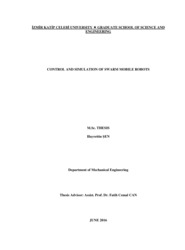Control and simulation of swarm mobile robots
-
Eser Sahibi
Şen, Hayrettin
- Tez Danışmanı Fatih Cemal CAN
-
Tür
Yüksek Lisans
- Yayın Tarihi 2016
-
Yayıncı
İzmir Katip Çelebi Üniversitesi Fen Bilimleri Enstitüsü
- Tek Biçim Adres Http://hdl.handle.net/11469/644
-
Konu Başlıkları
Mobil robotlar
Mobile robots
This thesis presents both control of mobile robots that can move by using collective motion algorithm and simulation of the robots during the motion. The orientation of the robots was controlled remotely by one user during the collective motion. The transmission of orientation data from the remote controller to the robots was done by using XBee modules. The control algorithm of collective motion was developed by using individual-based model. Two modes are considered during the control. These modes are search and swarm mode.
The collective motion was performed by robots that are moving with respect to some pair-wise interactions. The pair-wise interactions between the robots were proposed based on three rules namely attraction, parallel orientation and repulsion fields rules. While the mobile robots try to move toward their neighbors in attraction field, they try to remain close to their neighbors in parallel orientation field. The repulsion field rule avoids the collision with each other during the collective motion.
Since the commercial mobile robots which can be used in swarm robotics are very expensive, the robots used in this study were manufactured in the Prototyping Laboratory, in Izmir Katip Çelebi University. The mechanical parts of mobile robots were designed using SolidWorks and manufactured by using 3D printer technology. Arduino Mega 2560 programmable board was used as control unit of the robots. One electronic circuit, named Arduino Shield Circuit was designed using Proteus 8 Professional. It was produced in order to connect the used electronic components to related pins on Arduino Mega 2560 easily and in a secure way avoiding short circuits.
The simulation code works as a real-time simulation. The code uses the data received from the robots to simulate the motion of the robots. The simulation also saves the all the received data from the robots to one Excel file. Two parameters, polarization and expanse were calculated in order to observe and characterize the motion of the swarm robots by using the saved data.
Lastly the collective motion was tested for a group of two, three, four and five robots. The expanse and polarization values were presented for each test.
-
Koleksiyonlar
ENSTİTÜLER
FEN BİLİMLERİ ENSTİTÜSÜ

 Tam Metin
Tam Metin

